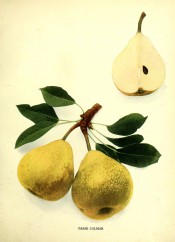Pyrus communis ‘Passe Colmar’
‘Fruit middle-sized, obconical, flattened at the crown, about three inches and a half long, and three inches in diameter. Eye open, slightly sunk. Stalk one inch and a half long, strong, inserted in an oblique obtusely-angled cavity. Skin green, when ripe becoming yellowish, and sprinkled with russet, and if well exposed having a considerable tinge of red; the surface is somewhat uneven, with some slight longitudinal furrows running from the stalk end. Flesh yellowish, melting, juicy, very rich, and most excellent. In perfection in December and January.’ [George Lindley – Orchard Guide p.404/1831].
Horticultural & Botanical History
It was raised by M. Hardenpont at Mons in 1758. The large number of synonyms attests to the popularity of this pear. It was known as Chapman’s pear in the London markets after the person who introduced it to England.
‘From its ripening late, bearing most abundantly, and possessing a peculiarly rich and agreeable flavour, this Pear has become a universal favourite, and deservedly. It was raised in Flanders by a M. Hardenpont, to whom, in conjunction with Dr. Van Mons, and some others of his countrymen, we are indebted for several very excellent varieties of the Pear.
With regard to the numerous synonyms which we have quoted, we are disposed to think that they are all referable to one and the same thing. It is true that, according to Van Mons, the origin of some of them is different; but, even supposing this to be true, and not a mistake, yet as it is impossible to distinguish them by any one character of either wood, fruit, or period of maturity, it is useless to continue to speak of them as distinct.
At the period when so large an introduction took place of Pears from Flanders, some cuttings of this variety fell into the hands of a market-gardener of the name of Chapman, by whom it has been sold extensively as “Chapman’s Pear”’’ [PM t.64/1829 ]. Also Figured in Pears of New York [p.206/1821], the Herefordshire Pomona [HP pl.XXXVI/1878] and Saint-Hilaire [pl.90/1828].
‘Passe Colmar: colour brownish yellow; form obovate; size large; quality excellent. In use during April to June, and with good management much longer. It is one of the most popular winter pears, on account of its excellent flavour, vigorous growth, and abundant bearing.’ [NHM vol.1 p79/1864].
History at Camden Park
Listed in the 1845 catalogue as ‘Passe Colmar’, and in 1850 and 1857 as ‘Colmar’ [Pear no.12/1845]. These are different pears. It seems likely that ‘Colmar’ was intended but both have been included in the Hortus. There is no diary entry for this pear.
Notes
Published May 17, 2010 - 04:34 PM | Last updated Jul 22, 2011 - 03:09 PM
| Family | Rosaceae |
|---|---|
| Category | |
| Region of origin | Garden origin, Belgium |
| Synonyms |
|
| Common Name | Dessert Pear, winter |
| Name in the Camden Park Record | Passe Colmar Colmar
|
| Confidence level | low |
